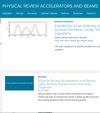Effects of processing history on the evolution of surface damage layer and dislocation substructure in large grain niobium cavities
Physical Review Special Topics-accelerators and Beams
Pub Date : 2015-12-16
DOI:10.1103/PHYSREVSTAB.18.123501
引用次数: 3
Abstract
Large grain niobium (Nb) is being investigated for fabricating superconducting radiofrequency cavities as an alternative to the traditional approach using fine grain polycrystalline Nb sheets. Past studies have identified a surface damage layer on fine grain cavities due to deep drawing and demonstrated the necessity for chemical etching on the surface. However, the origin of and depth of the damage layer are not well understood, and similar exploration on large grain cavities is lacking. In this work, electron backscatter diffraction (EBSD) was used to examine the cross sections at the equator and iris of a half cell deep drawn from a large grain Nb ingot slice. The results indicate that the damage (identified by a high density of geometrically necessary dislocations) depends on crystal orientations, is different at the equator and iris, and is present through the full thickness of a half cell in some places. After electron backscatter diffraction, the specimens were heat treated at 800 °C or 1000 °C for two hours, and the same areas were reexamined. A more dramatic decrease in dislocation content was observed at the iris than the equator, where some regions exhibited no change. The specimens were then etched and examined again, tomore » determine if the subsurface region behaved differently than the surface. As a result, little change in the dislocation substructure was observed, suggesting that the large grain microstructure is retained with a normal furnace anneal.« less加工历史对大晶粒铌空腔表面损伤层和位错亚结构演变的影响
大晶粒铌(Nb)正在被研究用于制造超导射频腔,作为使用细晶粒多晶铌片的传统方法的替代方案。过去的研究已经确定了由于深拉深而导致的细晶粒空腔表面损伤层,并证明了在表面进行化学蚀刻的必要性。然而,目前对损伤层的成因和深度还不清楚,对大颗粒空腔的类似勘探还很缺乏。本文采用电子背散射衍射(EBSD)技术,对大晶粒铌锭片半胞深的赤道和虹膜截面进行了研究。结果表明,损伤(由高密度的几何必要位错识别)取决于晶体取向,在赤道和虹膜处是不同的,并且在某些地方存在于半个细胞的整个厚度。电子背散射衍射后,分别在800℃或1000℃下热处理2小时,并对相同区域进行复查。在虹膜处观察到的脱位含量的减少比赤道处更剧烈,赤道处有些区域没有变化。然后对标本进行蚀刻和再次检查,以确定地下区域的行为是否与表面不同。结果表明,位错亚结构变化不大,表明在正常的炉内退火后仍保留了大晶粒组织。«少
本文章由计算机程序翻译,如有差异,请以英文原文为准。
求助全文
约1分钟内获得全文
求助全文
来源期刊
自引率
0.00%
发文量
0
审稿时长
3-8 weeks
期刊介绍:
Physical Review Special Topics - Accelerators and Beams (PRST-AB), is a peer reviewed, purely electronic journal, distributed without charge to readers and funded by contributions from national laboratories. It covers the full range of accelerator science and technology: subsystem and component technologies, beam dynamics; accelerator applications; and design, operation, and improvement of accelerators used in science and industry. This includes accelerators for high-energy and nuclear physics, synchrotron radiation production, spallation neutron sources, medical therapy, and intense beam applications.

 求助内容:
求助内容: 应助结果提醒方式:
应助结果提醒方式:


